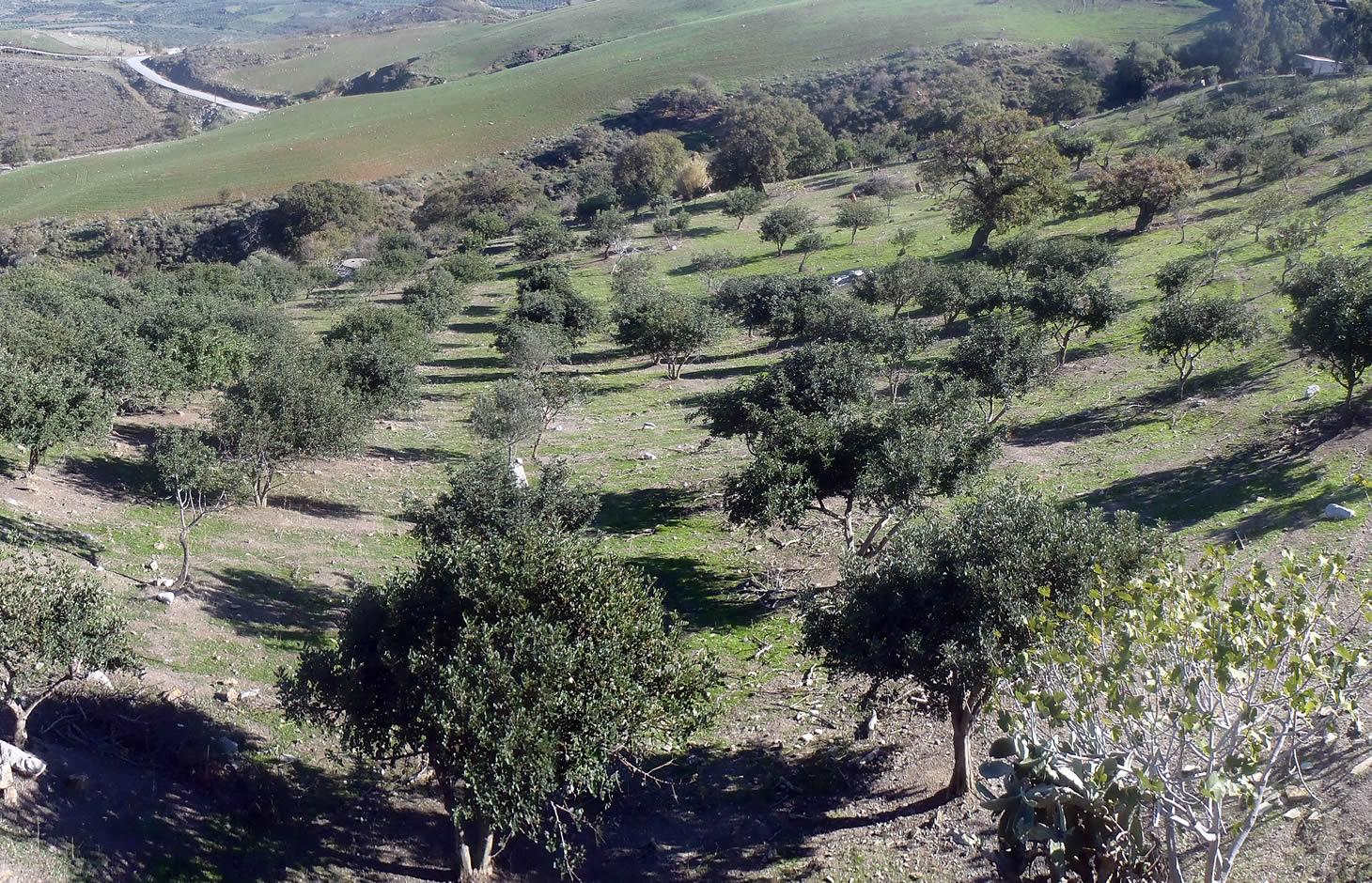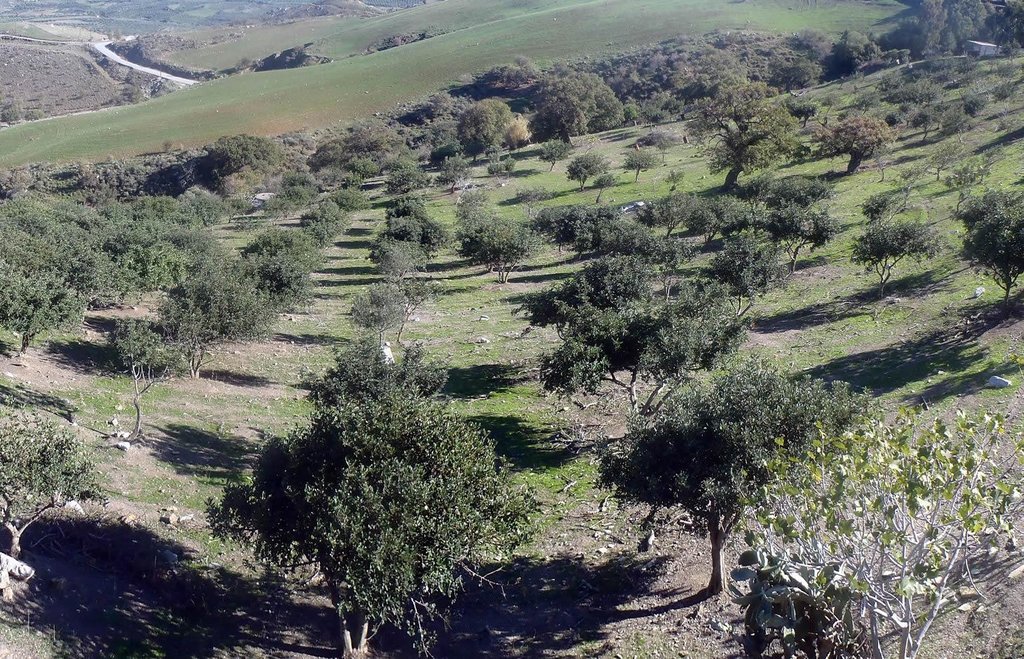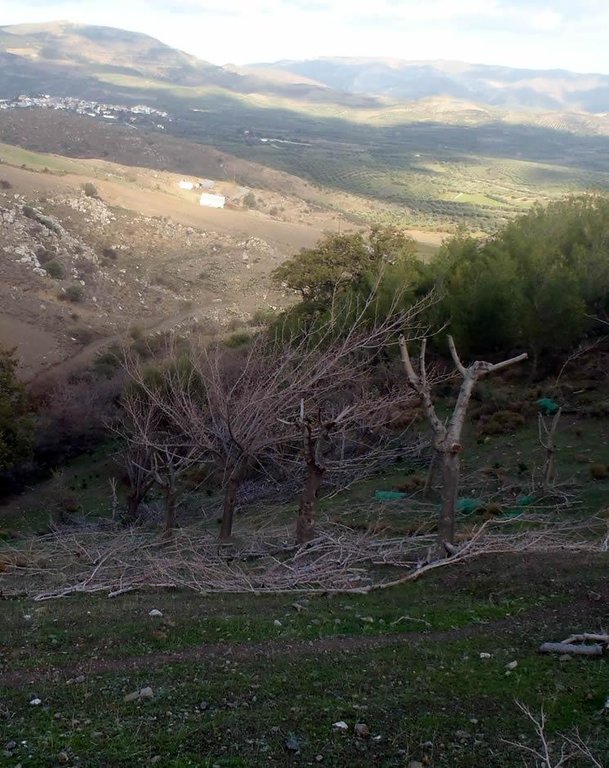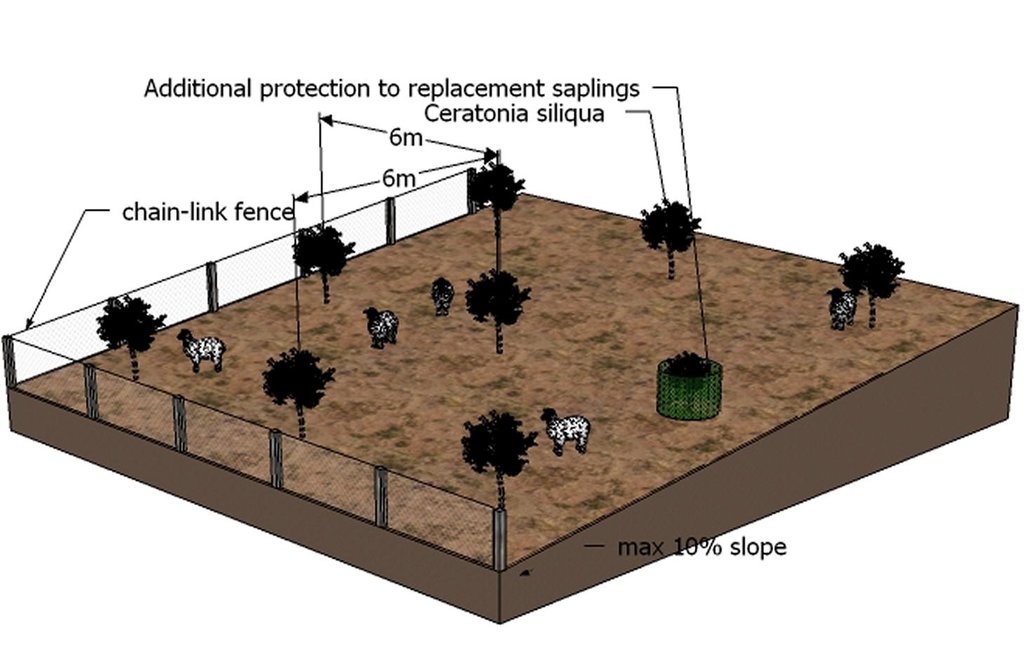Grazing land afforestation with Ceratonia siliqua (carob trees) in the Mediterranean [希腊]
- 创建:
- 更新:
- 编制者: Ioannis Daliakopoulos
- 编辑者: –
- 审查者: Deborah Niggli, Alexandra Gavilano
Φύτευση βοσκότοπου με Ceratonia siliqua (χαρουπιές) στη Μεσόγειο (EL)
technologies_1600 - 希腊
查看章节
全部展开 全部收起1. 一般信息
1.2 参与该技术评估和文件编制的资源人员和机构的联系方式
SLM专业人员:
Tsanis Ioannis
Technical University of Crete, Greece
希腊
有助于对技术进行记录/评估的项目名称(如相关)
Catastrophic shifts in drylands (EU-CASCADE)有助于对技术进行记录/评估的机构名称(如相关)
Technical University of Crete (Technical University of Crete) - 希腊1.3 关于使用通过WOCAT记录的数据的条件
编制者和关键资源人员接受有关使用通过WOCAT记录数据的条件。:
是
1.4 所述技术的可持续性声明
这里所描述的技术在土地退化方面是否存在问题,导致无法被认为是一种可持续的土地管理技术?:
否
2. SLM技术的说明
2.1 技术简介
技术定义:
Graze land forestation with Ceratonia siliqua (carob trees)
2.2 技术的详细说明
说明:
A stand of Ceratonia siliqua (carob trees) is established within an area used for grazing. Tree density is average (6 m grid configuration) and the majority of maintenance input is limited to the first 3 years. Once established, grazing can continue with few limitations. Ceratonia siliqua (carob tree) is very characteristic of the Mediterranean region, thus blending in very well with the local landscape, especially in the rugged agro-pastoral areas of the Mediterranean islands.
After the successful establishment of the plantation, intense irrigation is no longer required and livestock can be allowed in the afforested area which has been upgraded to an improved agro-pastoral or agroforestry land. This improvement facilitates a healthier ecosystem that mitigates land degradation by stabilizing soil, increasing infiltration and organic matter and promoting flora and fauna. In addition to those traits, Ceratonia siliqua is fire resistant and can promote market diversification for the farmer. The main drawback of this technology is the reduction in livestock and other crop production during the first decade of application until trees are mature.
The purpose of this technology is multifold. The primary goal is to increase ecosystem services provided by the treated area, especially for grazing. The farmer takes advantage of the qualities of carob trees for providing:
(a) Fodder to the livestock from the carob pods as well as leaves from cuttings;
(b) Shade to the livestock during the summer months;
(c) Better soil retention, water infiltration etc.
A secondary goal is to increase market diversification with the direct exploitation of carob beans for various products, such as carob honey and carob flour. These products give added value to the land and allow the farmer to increase his income in a more sustainable way.
At the same time much is gained from various other ecosystem services relevant to habitat and supporting services for the fauna of the area, such as birds and honey-bees. The aesthetic value of the landscape which strongly linked with Cretan traditions and pastoralism lifestyle is enhanced. The touristic attraction of the area is greatly improved providing new options for recreational activities and exploitation through actions such as agro-tourism.
Initially, few structural measures are required, mostly related to preparing slopes and soil for sapling planting and establishing irrigation infrastructure. A palisade that will effectively prevent livestock from damaging young trees needs to be maintained during the first 10 years of application of the technology. 2-year-old saplings are planted in a grid configuration with spacing of 6 m and actively managed for at least 3 years. Management includes watering, fertilization and replacement of dead or weak saplings.
The average annual precipitation in the area is 690 mm and the climate is classified as subhumid. Average annual temperature is 17.5 oC with 7 months below 18 but above 5, thus classifying the area as subtropical. In the location where the technology is applied, land is mostly individually owned and distributed among a few families of a community of about 100 inhabitants. Although the financial means of the land user who applies this technology are more or less on par with those of the rest of the community, he has a wider empirical education and relatively higher social status acquired thought his involvement with the commons.
2.3 技术照片
2.5 已应用该技术的、本评估所涵盖的国家/地区/地点
国家:
希腊
区域/州/省:
Heraklion
有关地点的进一步说明:
Melidochorion/Kastriotis
注释:
Total area covered by the SLM Technology is 0.05 km2.
2.6 实施日期
如果不知道确切的年份,请说明大概的日期:
- 10-50年前
2.7 技术介绍
详细说明该技术是如何引入的:
- 通过项目/外部干预
3. SLM技术的分类
3.1 该技术的主要目的
- 改良生产
- 减少、预防、恢复土地退化
3.2 应用该技术的当前土地利用类型
同一土地单元内混合使用的土地::
是
具体说明混合土地使用(作物/放牧/树木):
- 农牧业(包括农牧结合)

农田
- 乔木与灌木的种植
乔木和灌木种植 - 指定作物:
- 角豆树

牧场
注释:
Tree and shrub cropping: Ceratonia siliqua (carob tree)
Major land use problems (compiler’s opinion): The main problems are reduced land cover that progressively leads to soil erosion, combined with the lack of sufficient water resources in the wider area.
Major land use problems (land users’ perception): Land users perceive a problem of reduced pasture fodder availability thus residing to more expensive solutions
Livestock density: 50-100 LU /km2
3.4 供水
该技术所应用土地的供水:
- 混合雨水灌溉
3.5 该技术所属的SLM组
- 天然和半天然森林管理
- 农业林学
- 畜牧业和牧场管理
3.6 包含该技术的可持续土地管理措施

植物措施
- V1:乔木和灌木覆盖层

结构措施
- S6:墙、障碍物、栅栏、围墙
注释:
Type of vegetative measures: aligned: -linear
3.7 该技术强调的主要土地退化类型

土壤水蚀
- Wt:表土流失/地表侵蚀

生物性退化
- Bc:植被覆盖的减少
- Bq:数量/生物量减少
注释:
Main causes of degradation: overgrazing
Secondary causes of degradation: education, access to knowledge and support services
3.8 防止、减少或恢复土地退化
具体数量名该技术与土地退化有关的目标:
- 防止土地退化
- 修复/恢复严重退化的土地
4. 技术规范、实施活动、投入和成本
4.1 该技术的技术图纸
技术规范(与技术图纸相关):
A stand of Ceratonia siliqua (carob trees) is established within an area used for grazing. For at least 10 years the area is fenced adequately to exclude livestock; once trees are mature sheep can return to graze. If a tree needs to be replaced after establishment, it can be individually fenced.
Technical knowledge required for field staff / advisors: moderate (advice from technical staff is required for each of the plantation establishment stages)
Technical knowledge required for land users: moderate
Main technical functions: improvement of ground cover
Secondary technical functions: improvement of topsoil structure (compaction), stabilisation of soil (eg by tree roots against land slides), increase in organic matter, promotion of vegetation species and varieties (quality, eg palatable fodder), control of fires
Aligned: -linear
Vegetative material: T : trees / shrubs
Number of plants per (ha): 120
Vertical interval within rows / strips / blocks (m): 6
Width within rows / strips / blocks (m): 6
Trees/ shrubs species: Ceratonia siliqua
Construction material (other): chain-link fence
作者:
I. Daliakopoulos
4.2 有关投入和成本计算的一般信息
其它/国家货币(具体说明):
Euro
如相关,注明美元与当地货币的汇率(例如1美元=79.9巴西雷亚尔):1美元=:
0.73
注明雇用劳工的每日平均工资成本:
80.00
4.3 技术建立活动
| 活动 | 时间(季度) | |
|---|---|---|
| 1. | Planting saplings | Winter |
| 2. | Grafting | in the 4th year of establishment |
| 3. | Slope/soil preparation | Before planting |
| 4. | Chain-link fencing | Before planting |
| 5. | Irrigation piping | Before planting |
4.4 技术建立所需要的费用和投入
| 对投入进行具体说明 | 单位 | 数量 | 单位成本 | 每项投入的总成本 | 土地使用者承担的成本% | |
|---|---|---|---|---|---|---|
| 劳动力 | labour | ha | 1.0 | 3760.0 | 3760.0 | |
| 设备 | machine use | ha | 1.0 | 3020.0 | 3020.0 | |
| 植物材料 | seedlings | ha | 1.0 | 820.0 | 820.0 | |
| 施工材料 | chain-link fence | ha | 1.0 | 1900.0 | 1900.0 | |
| 施工材料 | pipes | ha | 1.0 | 270.0 | 270.0 | |
| 技术建立所需总成本 | 9770.0 | |||||
| 技术建立总成本,美元 | 13383.56 | |||||
4.5 维护/经常性活动
| 活动 | 时间/频率 | |
|---|---|---|
| 1. | Fertilization | |
| 2. | Replacing dead or weak trees | whenever necessary |
| 3. | Pruning | once a year |
| 4. | Watering | twice per month during summer, once per month during the rest of the year |
4.6 维护/经常性活动所需要的费用和投入(每年)
| 对投入进行具体说明 | 单位 | 数量 | 单位成本 | 每项投入的总成本 | 土地使用者承担的成本% | |
|---|---|---|---|---|---|---|
| 劳动力 | labour | ha | 1.0 | 350.0 | 350.0 | |
| 植物材料 | seedlings | ha | 1.0 | 280.0 | 280.0 | |
| 肥料和杀菌剂 | fertilizer | ha | 1.0 | 160.0 | 160.0 | |
| 施工材料 | water | ha | 1.0 | 6.0 | 6.0 | |
| 技术维护所需总成本 | 796.0 | |||||
| 技术维护总成本,美元 | 1090.41 | |||||
5. 自然和人文环境
5.1 气候
年降雨量
- < 250毫米
- 251-500毫米
- 501-750毫米
- 751-1,000毫米
- 1,001-1,500毫米
- 1,501-2,000毫米
- 2,001-3,000毫米
- 3,001-4,000毫米
- > 4,000毫米
有关降雨的规范/注释:
690 mm
农业气候带
- 半湿润
Thermal climate class: subtropics
5.2 地形
平均坡度:
- 水平(0-2%)
- 缓降(3-5%)
- 平缓(6-10%)
- 滚坡(11-15%)
- 崎岖(16-30%)
- 陡峭(31-60%)
- 非常陡峭(>60%)
地形:
- 高原/平原
- 山脊
- 山坡
- 山地斜坡
- 麓坡
- 谷底
垂直分布带:
- 0-100 m a.s.l.
- 101-500 m a.s.l.
- 501-1,000 m a.s.l.
- 1,001-1,500 m a.s.l.
- 1,501-2,000 m a.s.l.
- 2,001-2,500 m a.s.l.
- 2,501-3,000 m a.s.l.
- 3,001-4,000 m a.s.l.
- > 4,000 m a.s.l.
5.3 土壤
平均土层深度:
- 非常浅(0-20厘米)
- 浅(21-50厘米)
- 中等深度(51-80厘米)
- 深(81-120厘米)
- 非常深(> 120厘米)
表土有机质:
- 中(1-3%)
5.4 水资源可用性和质量
地下水位表:
> 50米
地表水的可用性:
中等
水质(未处理):
良好饮用水
5.5 生物多样性
物种多样性:
- 高
5.6 应用该技术的土地使用者的特征
非农收入:
- > 收入的50%
相对财富水平:
- 平均水平
个人或集体:
- 个人/家庭
性别:
- 男人
说明土地使用者的其他有关特征:
Land users applying the Technology are mainly Leaders / privileged
Population density: < 10 persons/km2
Annual population growth: negative; 1%
5.7 应用该技术的土地使用者使用的平均土地面积
- < 0.5 公顷
- 0.5-1 公顷
- 1-2 公顷
- 2-5公顷
- 5-15公顷
- 15-50公顷
- 50-100公顷
- 100-500公顷
- 500-1,000公顷
- 1,000-10,000公顷
- > 10,000公顷
这被认为是小规模、中规模还是大规模的(参照当地实际情况)?:
- 中等规模的
5.8 土地所有权、土地使用权和水使用权
土地所有权:
- 个人,有命名
土地使用权:
- 个人
用水权:
- 社区(有组织)
5.9 进入服务和基础设施的通道
健康:
- 贫瘠
- 适度的
- 好
教育:
- 贫瘠
- 适度的
- 好
技术援助:
- 贫瘠
- 适度的
- 好
就业(例如非农):
- 贫瘠
- 适度的
- 好
市场:
- 贫瘠
- 适度的
- 好
能源:
- 贫瘠
- 适度的
- 好
道路和交通:
- 贫瘠
- 适度的
- 好
饮用水和卫生设施:
- 贫瘠
- 适度的
- 好
金融服务:
- 贫瘠
- 适度的
- 好
6. 影响和结论性说明
6.1 该技术的现场影响
社会经济效应
生产
饲料生产
饲料质量
畜牧生产
注释/具体说明:
during the first 10 years
木材生产
生产故障风险
注释/具体说明:
30% failure rate
产品多样性
水资源可用性和质量
灌溉用水需求
收入和成本
农业投入费用
注释/具体说明:
after at least 10 years
收入来源的多样性
社会文化影响
文化机会
娱乐机会
注释/具体说明:
agro-tourism opportunities
冲突缓解
生态影响
水循环/径流
地表径流
土壤
土壤水分
土壤覆盖层
土壤流失
养分循环/补给
生物多样性:植被、动物
生物量/地上C
植物多样性
动物多样性
有益物种
栖息地多样性
害虫/疾病控制
减少气候和灾害风险
火灾风险
风速
6.3 技术对渐变气候以及与气候相关的极端情况/灾害的暴露和敏感性(土地使用者认为的极端情况/灾害)
其他气候相关的后果
其他气候相关的后果
| 该技术是如何应对的? | |
|---|---|
| droughts / dry spells for the first 3 years | 不好 |
6.4 成本效益分析
技术收益与技术建立成本相比如何(从土地使用者的角度看)?
短期回报:
消极
长期回报:
积极
技术收益与技术维护成本/经常性成本相比如何(从土地使用者的角度看)?
短期回报:
轻度消极
长期回报:
积极
6.5 技术采用
在所有采用这项技术的人当中,有多少人是自发的,即未获得任何物质奖励/付款?:
- 91-100%
注释:
1 land user families have adopted the Technology with external material support
There is no trend towards spontaneous adoption of the Technology
6.7 该技术的优点/长处/机会
| 土地使用者眼中的长处/优势/机会 |
|---|
| Increased income through the provision of free fodder for the livestock. |
| Restoration and protection of pastureland from further degradation. |
| Provision of additional market opportunities to the land user. |
| 编制者或其他关键资源人员认为的长处/优势/机会 |
|---|
| Restoration and protection of pastureland from further degradation. |
| Provision of additional market opportunities to the land user. |
6.8 技术的弱点/缺点/风险及其克服方法
| 土地使用者认为的弱点/缺点/风险 | 如何克服它们? |
|---|---|
| Decreased income though the reduction of livestock density (exclusion) for at least 10 years. | Receive financial assistance (subsidies) per excluded animal. Voluntary contribution of local farmers to benefit from economies of scale (for unions). |
| Decrease of vegetation under the tree canopy. | Reduce carob tree density. |
| 编制者或其他关键资源人员认为的弱点/缺点/风险 | 如何克服它们? |
|---|---|
| Decreased income though the reduction of livestock density (exclusion) for at least 10 years. | Receive financial assistance (subsidies) per excluded animal. |
| Cannot implement in higher altitude pastureland due to the nature of the carob tree. | Perform afforestation with Mulberries (Morus nigra) |
7. 参考和链接
7.1 信息的方法/来源
- 实地考察、实地调查
- 与土地使用者的访谈
(现场)数据是什么时候汇编的?:
06/12/2013
链接和模块
全部展开 全部收起链接
无链接
模块
无模块





